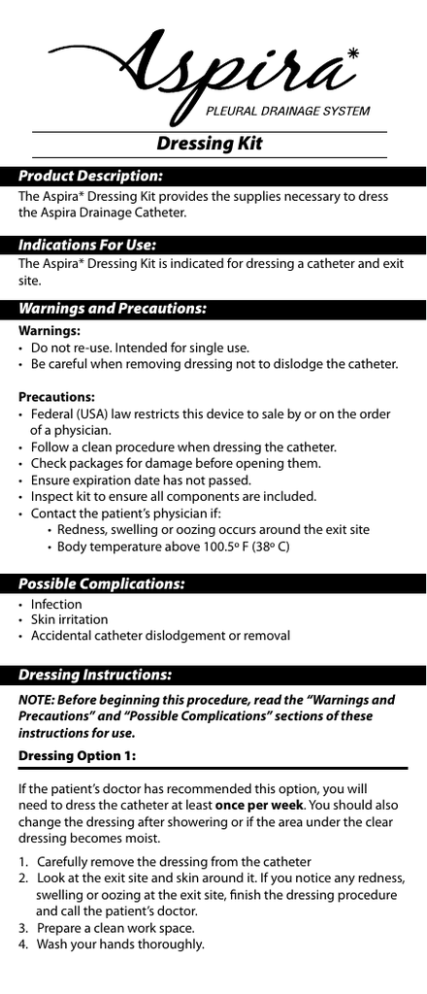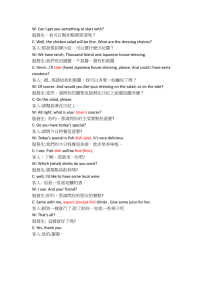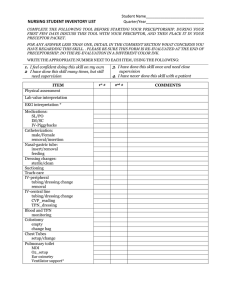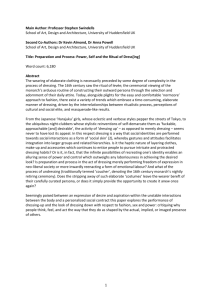
Dressing Kit
Product Description:
The Aspira* Dressing Kit provides the supplies necessary to dress
the Aspira Drainage Catheter.
Indications For Use:
The Aspira* Dressing Kit is indicated for dressing a catheter and exit
site.
Warnings and Precautions:
Warnings:
• Do not re-use. Intended for single use.
• Be careful when removing dressing not to dislodge the catheter.
Precautions:
• Federal (USA) law restricts this device to sale by or on the order
of a physician.
• Follow a clean procedure when dressing the catheter.
• Check packages for damage before opening them.
• Ensure expiration date has not passed.
• Inspect kit to ensure all components are included.
• Contact the patient’s physician if:
• Redness, swelling or oozing occurs around the exit site
• Body temperature above 100.5º F (38º C)
Possible Complications:
• Infection
• Skin irritation
• Accidental catheter dislodgement or removal
Dressing Instructions:
NOTE: Before beginning this procedure, read the “Warnings and
Precautions” and “Possible Complications” sections of these
instructions for use.
Dressing Option 1:
If the patient’s doctor has recommended this option, you will
need to dress the catheter at least once per week. You should also
change the dressing after showering or if the area under the clear
dressing becomes moist.
1. Carefully remove the dressing from the catheter
2. Look at the exit site and skin around it. If you notice any redness,
swelling or oozing at the exit site, finish the dressing procedure
and call the patient’s doctor.
3. Prepare a clean work space.
4. Wash your hands thoroughly.
5. Place the gloves on your clean hands holding them at the
cuffed end.
6. Open the sterile sheet and lay it flat on the cleaned work space.
7. Clean exit site with alcohol.
NOTE: Make sure the exit site and skin around it are dry before
completing the dressing.
8. Place clear dressing on the skin around the exit site.
9. Tape the catheter to the skin where it is most comfortable for the
patient.
NOTE: You will not need to use gauze for this dressing option.
Dressing Option 2:
If the patient’s doctor has recommended this dressing option, you
will need to change the dressing around the catheter every time
you drain fluid from the catheter. You should also change the
dressing after showering or if the area beneath the clear dressing
becomes moist.
1. Carefully remove the dressing from the catheter.
2. Look at the exit site and skin around it. If you notice anything
odd such as redness, swelling or oozing at the exit site, finish the
dressing procedure and call the patient’s doctor.
3. Prepare a clean work space.
4. Wash your hands thoroughly.
5. Place the gloves on your clean hands holding them at the
cuffed end.
6. Open sterile sheet and lay flat on the cleaned work space.
7. Clean exit site with alcohol.
NOTE: Make sure the exit site and skin around it are dry before
completing the dressing.
8. Place the split gauze pad on the skin around the catheter.
9. Coil the catheter on top of the pad. Place gauze over the top of
the coiled catheter.
10. Hold gauze, coiled catheter and split pad in position
11. Place clear dressing over the catheter and gauze. Make sure the
clear dressing sticks to the skin around the gauze. Smooth down
the dressing edges.
An issued or revision date for these instructions is included for the users
information. In the event two years have elapsed between this date and the
products use, the user should contact Bard Access Systems, Inc. to see if
additional product information is available.
Revised Date: March 2007
U.S. Patents Pending.
* Bard and Aspira are trademarks and/or registered trademarks of C. R.
Bard, Inc., or an affiliate.
© Copyright 2007 C. R. Bard, Inc.
All rights reserved. Printed in the U.S.A.
Bard Access Systems, Inc.
Salt Lake City, UT 84116 USA
801-595-0700
Home Supply Ordering: 866-433-3471
Hospital Ordering Information: 800-545-0890
Clinical Information: 866-893-2691
www.bardaccess.com
www.myaspira.com
Reorder Number:
4991503
0714747 / 0703R





